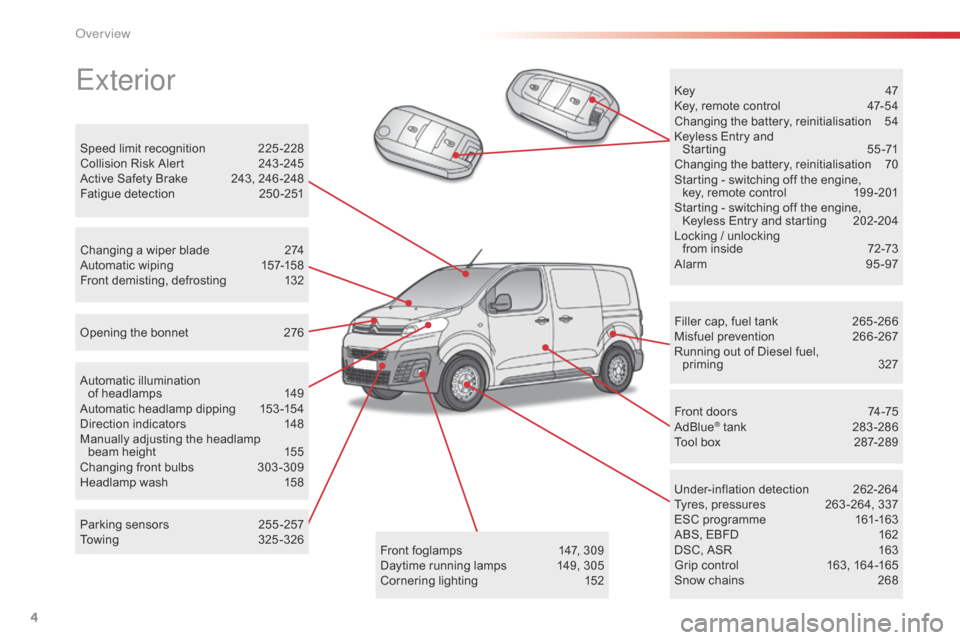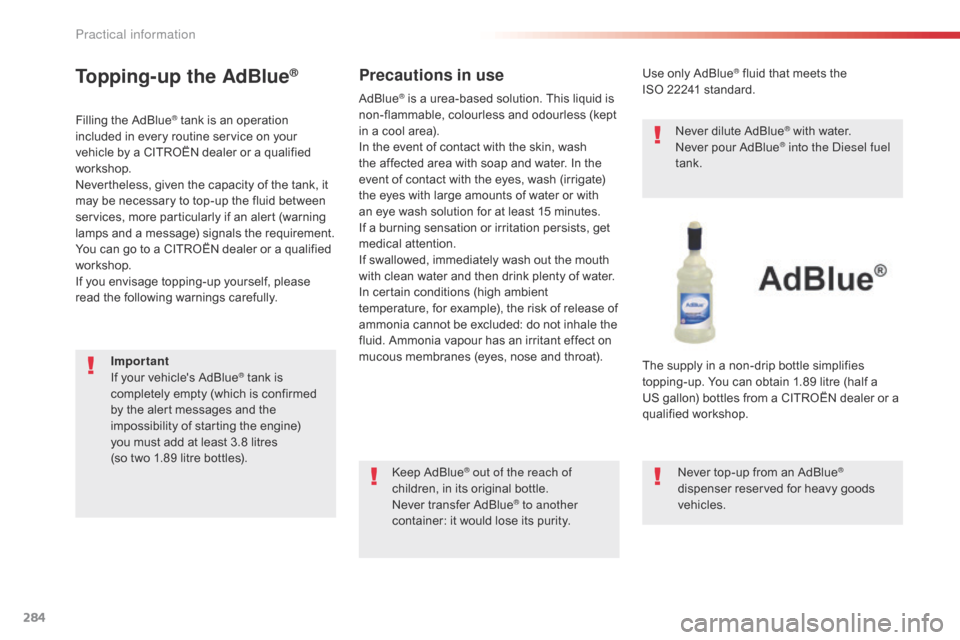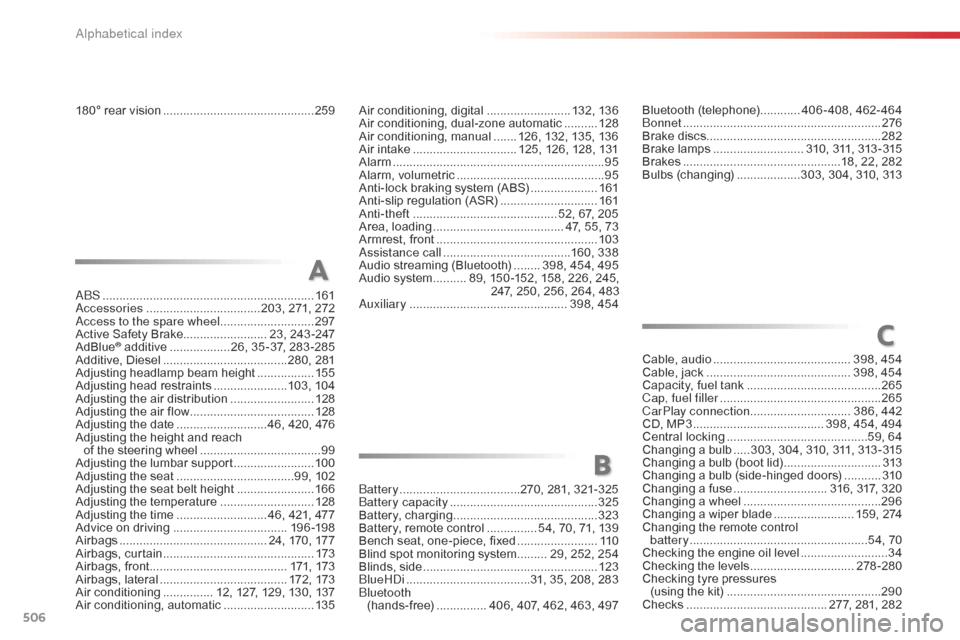fuel cap Citroen JUMPY RHD 2016 2.G Owner's Manual
[x] Cancel search | Manufacturer: CITROEN, Model Year: 2016, Model line: JUMPY RHD, Model: Citroen JUMPY RHD 2016 2.GPages: 520, PDF Size: 10.54 MB
Page 6 of 520

4
Exterior
Filler cap, fuel tank 265 -266
Misfuel prevention 26 6-267
Running out of Diesel fuel, priming
3
27
Under-inflation detection
26
2-264
Tyres, pressures
2
63 -264, 337
ESC programme
1
61-163
ABS, EBFD
1
62
DSC, ASR
1
63
Grip control
1
63, 164-165
Snow chains
2
68
Front doors
7
4-75
AdBlue
® tank 28 3-286
Tool box 2 87-289
Automatic illumination
of headlamps
1
49
Automatic headlamp dipping
1
53 -154
Direction indicators
1
48
Manually adjusting the headlamp
beam height
1
55
Changing front bulbs
3
03 -309
Headlamp wash
1
58
Opening the bonnet
2
76 Key
47
K
ey, remote control
4
7-54
Changing the battery, reinitialisation
5
4
Keyless Entry and Starting
5
5-71
Changing the battery, reinitialisation
7
0
Starting - switching off the engine, key, remote control
1
99 -201
Starting - switching off the engine, Keyless Entry and starting
2
02-204
Locking / unlocking from inside
7
2-73
Alarm
9
5-97
Speed limit recognition
2
25 -228
Collision Risk Alert
2
43 -245
Active Safety Brake
2
43, 246 -248
Fatigue detection
2
50-251
Changing a wiper blade
2
74
Automatic wiping
1
57-158
Front demisting, defrosting
1
32
Front foglamps
1
47, 309
Daytime running lamps
1
49, 305
Cornering lighting
1
52
Parking sensors
2
55 -257
Towing
325
-326
Over view
Page 22 of 520

20
Warning / indicator lampStateCause Action / Observations
Door(s) open fixed, associated with
a message identifying
the door, if the speed
is below 6 mph
(10 km/h). A front, side or rear door (left-hand
side-hinged door or tailgate) is still
open.
Close the door in question.
If your vehicle has side-hinged rear doors and the
right-hand door is still open, it being open will not be
signalled by this warning lamp.
fixed, associated with
a message identifying
the door, together with
an audible signal if the
speed is above 6 mph
(10 km/h).
or Low fuel level
fixed, with the needle
in the red zone. When it first comes on there remains
less than 8 litres of fuel
in the tank.You must refuel as soon as possible to avoid running
out of fuel.
This warning lamp will come on every time the ignition
is switched on, until a sufficient addition of fuel is
made.
Fuel tank capacity: approximately 69 litres
.
Never continue to drive until you run out of fuel as
this could damage the emission control and injection
systems.
fixed (only with the
LCD instrument
panel).
Presence of
water in the
Diesel fuel fixed (only with the
LCD instrument
panel). The Diesel fuel filter contains water. There is a risk of damage to the injection system.
Contact a CITROËN dealer or a qualified workshop
without delay.
Instruments
Page 49 of 520

47
Unfolding / Folding the key
If you do not press the button, you risk
damaging the remote control.
It allows the central locking or unlocking of the
vehicle using the door lock or from a distance.
It also allows the vehicle to be located, the fuel
filler cap to be removed and refitted and the
engine to be started or switched off, as well as
providing protection against theft.
Key, remote control
This separation of cab
and loading
area locking provides security in use.
It allows you to prevent access to the
part of the vehicle where you are not
present.
What is the point
of total or selective
unlocking?
Total unlocking allows all of the vehicle's doors
(front, side and rear) to be unlocked.
The remote control buttons are not
active when the ignition is switched on.
Selective unlocking allows either the cab
doors, or the loading area doors (side and
rear) to be unlocked.
Key
The key allows the central locking or unlocking
of the vehicle using the door lock.
It also allows the fuel filler cap to be removed
and refitted and the engine started or
switched
off.
F
P
ress this button to unfold or fold the key.
2
Access
Page 267 of 520

265
Fuel tank
Opening
If your vehicle is fitted with Stop & Start,
never refuel with the engine in STOP
mode; you must switch off the ignition
using the key, or the START/STOP
button if your vehicle has Keyless Entry
and Starting.
F
Y
ou must switch off the engine.
F
I
f your vehicle has Keyless Entry and
Starting, unlock the vehicle.
F
O
pen the filler flap.
Refuelling
Additions of fuel must be of at least 8 litres to
be registered by the fuel gauge.
Opening the filler cap may result in an inrush of
air. This vacuum is entirely normal and results
from the sealing of the fuel system.
F
R
emove the filler cap by unscrewing it,
then place it on the carrier located on the
filler flap.
F
I
ntroduce the nozzle and push it in fully
(pushing on the metal non-return valve A ).
F
F
ill the tank. Do not continue past the third
cut-off of the nozzle, as this may cause
malfunctions.
F
R
efit the filler cap turning it to the right.
F
P
ush the filler flap to close it (your vehicle
must be unlocked).
F
T
ake care to select the pump that delivers
the correct fuel type for your vehicle's
engine (reminder on a label on the inside of
the filler flap).
Capacity of the tank: approximately 69
litres.
F
I
f your vehicle has a conventional key,
introduce the key into the filler cap, then
turn it to the left.
7
Practical information
Page 268 of 520

266
Low fuel level
When the low fuel level in
the tank is reached, this
warning lamp comes on
in the instrument panel,
accompanied by an audible
warning and a message.
Fuel supply cut-off
Your vehicle is equipped with a safety device
which cuts off the fuel supply in the event of a
collision. When it first comes on, less than 8 litres of fuel
remain in the tank.
You must refuel as soon as possible to avoid
running out.If you have put in the wrong fuel for
your vehicle, you must have the tank
drained and refilled with the correct
fuel before you star t the engine.
Your vehicle is fitted with a catalytic converter,
a device which helps to reduce the level of
harmful emissions in the exhaust gases.
Diesel misfuel
prevention
Mechanical device which prevents filling the
tank of a Diesel vehicle with petrol. It avoids
the risk of engine damage that can result from
filling with the wrong fuel.
Located in the filler neck, the misfuel
prevention device appears when the filler cap
is removed.
When a petrol filler nozzle is introduced into the
fuel filler neck of your Diesel vehicle, it comes
into contact with the flap. The system remains
closed and prevents filling.
Do not persist but introduce a Diesel filler
nozzle.
If your vehicle has sliding side doors, do
not open the left hand sliding door as
there is a risk of damaging the fuel filler
flap when refuelling.
Practical information
Page 279 of 520

277
* According to engine.
Diesel engine
1. Screenwash and headlamp wash reservoir.
2. Coolant header tank.
3.
E
ngine oil filler cap.
4.
E
ngine oil dipstick.
5.
P
riming pump*.
6.
B
rake fluid filler cap.
7.
B
attery.
8.
R
emote earth point ("-" terminal).
9.
F
usebox.
10.
P
ower steering fluid reservoir.
11.
A
ir filter. This engine is shown as an example. The locations of the engine oil dipstick and filler cap may vary.
The Diesel fuel system operates under
high pressure:
-
N
ever carry out any work on this
system yourself.
-
H
Di engines make use of advanced
technology.
All maintenance and repairs require
specially trained staff, which only a
CITROËN dealer can provide.
7
Practical information
Page 285 of 520

283
AdBlue® and SCR system
for BlueHDi Diesel engines
To assure respect for the environment and
conformity with the new Euro 6 emissions
standard, without adversely affecting the
per formance or fuel consumption of Diesel
engines, CITROËN has taken the decision to
equip its vehicles with an effective system that
associates SCR (Selective Catalytic Reduction)
with a particle filter (FAP) for the treatment of
exhaust gases.
Presentation of the SCR system
Using a fluid called AdBlue® containing urea, a
catalytic converter turns up to 85% of nitrogen
oxides (NOx) into nitrogen and water, which are
harmless to health and the environment. The AdBlue
® is held in a special tank with a
capacity of about 22 litres: this provides a
driving range of about 12 500 miles
(20 000 km), after which an alert is triggered
warning you when the reserve remaining is
enough for just 1 500 miles (2 400 km).
During each scheduled service of your vehicle
by a CITROËN dealer or a qualified workshop,
the AdBlue
® tank is refilled in order to allow
normal operation of the SCR system. Once the AdBlue
® tank is empty, a
s
ystem required by regulations prevents
starting of the engine.
If the SCR
is faulty, the level of
emissions from your vehicle will no
longer meet the Euro 6 standard: your
vehicle becomes polluting.
In the event of a confirmed fault
with the SCR system, you must go
to a CITROËN dealer or a qualified
workshop as soon as possible: after
a running distance of 650 miles
(1
100 km), a system will be triggered
automatically to prevent engine starting.
When filling the tank, the filling rate
must not exceed 40 litres per minute.
If the estimated mileage between two services
is greater than 12 500 miles (20 000 km), we
recommend that you go to a CITROËN dealer
or a qualified workshop to have the necessary
top-up carried out.
7
Practical information
Page 286 of 520

284
Topping-up the AdBlue®
Filling the AdBlue® tank is an operation
included in every routine service on your
vehicle by a CITROËN dealer or a qualified
workshop.
Nevertheless, given the capacity of the tank, it
may be necessary to top-up the fluid between
services, more particularly if an alert (warning
lamps and a message) signals the requirement.
You can go to a CITROËN dealer or a qualified
workshop.
If you envisage topping-up yourself, please
read the following warnings carefully.
Precautions in use
Keep AdBlue® out of the reach of
children, in its original bottle.
Never transfer AdBlue
® to another
container: it would lose its purity. Use only AdBlue
® fluid that meets the
ISO
22241 standard.
Never dilute AdBlue
® with water.
Never pour AdBlue® into the Diesel fuel
tank.
The supply in a non-drip bottle simplifies
topping-up. You can obtain 1.89 litre (half a
US gallon) bottles from a CITROËN
dealer or a
qualified workshop.
Never top-up from an AdBlue
®
dispenser reserved for heavy goods
vehicles.
AdBlue
® is a urea-based solution. This liquid is
non-flammable, colourless and odourless (kept
in a cool area).
In the event of contact with the skin, wash
the affected area with soap and water. In the
event of contact with the eyes, wash (irrigate)
the eyes with large amounts of water or with
an eye wash solution for at least 15 minutes.
If a burning sensation or irritation persists, get
medical attention.
If swallowed, immediately wash out the mouth
with clean water and then drink plenty of water.
In certain conditions (high ambient
temperature, for example), the risk of release of
ammonia cannot be excluded: do not inhale the
fluid. Ammonia vapour has an irritant effect on
mucous membranes (eyes, nose and throat).
Important
If your vehicle's AdBlue
® tank is
c
ompletely empty (which is confirmed
by the alert messages and the
impossibility of starting the engine)
you must add at least 3.8 litres
(so two 1.89 litre bottles).
Practical information
Page 334 of 520

332
Engines
Engine characteristics
The engine characteristics (capacity,
maximum power, maximum power speed, fuel,
CO
2 emissions...) for your vehicle are given in
t
he registration document, as well as in sales
brochures.
These characteristics correspond to the
values type-approved on a test bed, under
conditions defined in European legislation
(Directive
1
999/99/EC).
For more information, contact a CITROËN
dealer or a qualified workshop.
Weights
The kerb weight is equal to the unladen
weight + driver (75 kg).
The GTW and towed load values indicated
apply up to a maximum altitude of
1
000 metres; the towed load mentioned
must be reduced by 10 % for every additional
1
000 metres.
The weight of the braked trailer can be
increased, within the GTW limit, on condition
that the GV W of the towing vehicle is reduced
by the same amount.
The recommended nose weight is the vertical
load on the towbar ball (removable with or
without tools). High ambient temperatures may result
in a reduction in the per formance of
the vehicle to protect the engine; when
the ambient temperature is higher than
37
°C, limit the towed weight.
If the ambient temperature is high, it
is recommended that the engine be
allowed to idle for 1 to 2 minutes after
the vehicle comes to a stop, to facilitate
its cooling. Towing with a lightly loaded vehicle can
adversely affect roadholding.
Braking distances are increased when
towing a trailer.
Never exceed 60 mph (100 km/h) when
towing (comply with the legislation in
force in your country).
GV W:
gross vehicle weight, the maximum authorised vehicle weight.GT W: gross train weight, the maximum authorised weight of vehicle plus trailer.
Weights and towed
loads
The maximum weights and towed loads for your
vehicle are given are given in the registration
document, as well as in sales brochures.
These values are also present on the
manufacturer's plate or label.
For more information, contact a CITROËN
dealer or a qualified workshop.
Technical data
Page 508 of 520

506
180° rear vision .............................................259
ABS
........
....................................................... 161
Accessories
..............................
.... 203, 271, 272
Access to the spare wheel
............................2
97
Active Safety Brake......................... 23, 243 -247
AdBlue
® additive .................. 2 6, 35 -37, 283 -285
Additive, Diesel ............................... ......280, 281
Adjusting headlamp beam height
.................15
5
Adjusting head restraints
......................10
3, 104
Adjusting the air distribution
.........................12
8
Adjusting the air flow
..................................... 12
8
Adjusting the date
...........................4
6, 420, 476
Adjusting the height and reach of the steering wheel
.................................... 99
A
djusting the lumbar support
........................10
0
Adjusting the seat
..............................
.....99, 102
Adjusting the seat belt height
.......................16
6
Adjusting the temperature
............................12
8
Adjusting the time
........................... 4
6, 421, 477
Advice on driving
..............................
....19 6 -198
Airbags
...............
............................. 24, 170, 177
Airbags, curtain
............................................. 17
3
Airbags, front......................................... 171, 173
Airbags, lateral
...................................... 17
2 , 173
Air conditioning
............... 1
2, 127, 129, 130, 137
Air conditioning, automatic
...........................13
5Air conditioning, digital
.........................
13
2, 13 6
Air conditioning, dual-zone automatic
..........
12
8
Air conditioning, manual
....... 1
26, 132, 135, 136
Air intake
...............
................ 125, 126, 128, 131
Alarm
............................................................... 95
A
larm, volumetric
............................................
95
A
nti-lock braking system (ABS)
....................
16
1
Anti-slip regulation (ASR)
.............................
16
1
Anti-theft
..............................
............. 52, 67, 205
Area, loading
...............................
........ 47, 55, 73
Armrest, front
................................................
10
3
Assistance call
...............................
.......160, 338
Audio streaming (Bluetooth)
........ 3
98, 454, 495
Audio system
.......... 8
9, 150 -152, 158, 226, 245,
247, 250, 256, 264, 483
Auxiliary
............................................... 3
98, 454
A
C
B
Bluetooth (telephone) ............ 4
06 - 408, 462- 464
Bonnet ............... ............................................ 276
Brake discs
.................................................... 28
2
Brake lamps
........................... 31
0, 311, 313 - 315
Brakes
...............................................1
8, 22, 282
Bulbs (changing)
...................3
03, 304, 310, 313
Cable, audio
......................................... 3
98, 454
Cable, jack
..............................
............. 398, 454
Capacity, fuel tank
..............................
..........265
Cap, fuel filler
................................................ 26
5
CarPlay connection .............................. 386, 442
CD, MP3
....................................... 3
98, 454, 494
Central locking
..........................................5
9, 64
Changing a bulb
..... 3
03, 304, 310, 311, 313 -315
Changing a bulb (boot lid)
.............................3
13
Changing a bulb (side-hinged doors)
...........3
10
Changing a fuse
............................ 3
16, 317, 320
Changing a wheel
...............................
..........296
Changing a wiper blade
........................ 1
59, 274
Changing the remote control battery
.....................................................5
4, 70
Checking the engine oil level
..........................34
C
hecking the levels
...............................2
78-280
Checking tyre pressures (using the kit)
..............................
................290
Checks
...............
........................... 277, 281, 282
Battery
...............................
.....270, 281, 321-325
Battery capacity
...............................
............. 325
Battery, charging
...............................
............ 323
Battery, remote control
............... 5
4, 70, 71, 139
Bench seat, one-piece, fixed
........................ 11
0
Blind spot monitoring system
......... 2
9, 252, 254
Blinds, side
.................................................... 12
3
BlueHDi
...............................
......31, 35, 208, 283
Bluetooth (hands-free)
............... 4
06, 407, 462, 463, 497
Alphabetical index